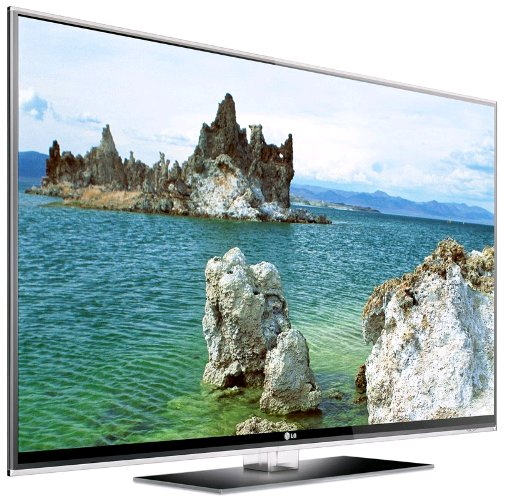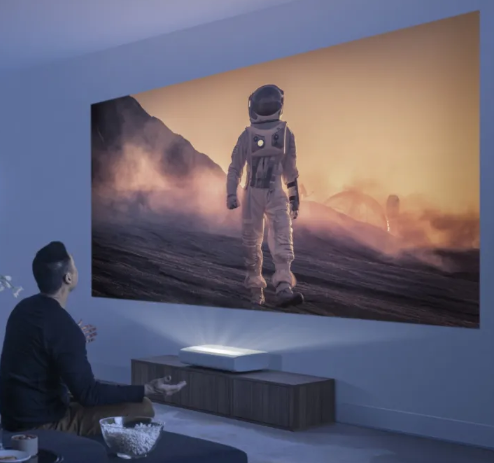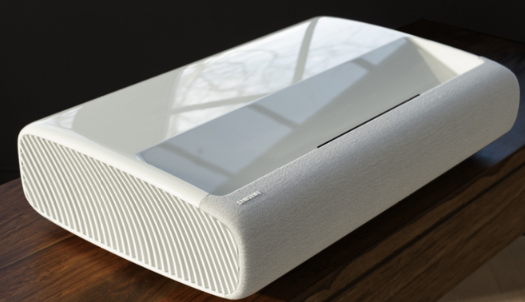
 |
TV Features Explained 2022-2023  What features to look for in a TV for 2022-2023 TV technology is moving faster and faster and expanding so much it is hard to keep up. Here are some of the new terms you should become familiar with in order to make an informed decision when buying a new TV. Screen size: Larger and larger is the trend now. 65 inch is the norm with 85 inch to follow. Samsung offers a 130 inch screen using a laser projector TV unit which sits close to the wall, under the screen. Make sure to place the big screen in an appropriate room size. Display panel technology: LED-LCD, OLED, QD-OLED, MicroLED LED-LCD TV displays are LCD TVs with LED backlights. They are the most abundant and least expensive overall. OLED or Organic Light Emitting Diode displays are super thin because they do not need any backlight. OLED panels are more expensive, not as bright, but offer better contrast and vibrant colors. OLED panels have been improved over the last years and are in demand due to their high tech looks. Quantum Dot OLED is a panel from Samsung designed to improve on OLED by increasing brightness while keeping all the best features of OLED. QD-OLED screens differ from the traditional OLED panels that have long been manufactured by LG Display in the way they produce an image. LG’s displays are considered WRGB OLED, because they use blue and yellow OLED compound to generate white-ish light pixels that are passed through color filters to produce red, green, and blue sub-pixels. More recent OLED TVs also have a fourth unfiltered / white sub-pixel meant to enhance brightness — especially for HDR content. QD-OLED changes this by emitting blue light through quantum dots to convert some of that blue into red and green without any need for the color filter. Blue is used because it has the strongest light energy. This leads to greater light energy efficiency; since you’re not losing any light to the color filters, QD-OLED TVs should offer brightness gains compared to past-generation OLEDs. MicroLED - Samsung’s MicroLED displays bring together the best features of OLED — self-emitting pixels, perfect blacks, without most of the drawbacks. MicroLEDs use microscopic, inorganic LEDs that individually produce light and color. Currently are wildly expensive. Tuners: ATSC 1.0, ATSC 3.0 Over-The-Air TV Broadcasts ATSC 1.0 = 1080i ATSC 3.0 = 4K and 3.0 broadcast TV station in local area 3.0 converter box available for TV with ATSC 1.0 tuner. Since 2009, ATSC 1.0 tuners have been prevalent in most tuner-integrated devices when the United States decided to fully shift from the analog NTSC standard to the digital ATSC. ATSC tuner-equipped devices can receive over-the-air (OTA) broadcast signals from TV stations for free. ATSC tuners have a string of other functions such as demultiplexing, decompression, analog-to-digital conversion, error corrections, media reformatting, and AV synchronization. ATSC 1.0 is being slowly replaced with ATSC 3.0 for a number of reasons. If possible, to future-proof your TV, get ATSC 3.0 Tuner built-in to TV. Wi-Fi: Wireless access to Internet content, phone screen mirroring and more. Built-in WiFi in TVs can be based on different WiFi versions WiFi 4 (802.11n) supports up to 450 Mb/s. WiFi 5 (802.11ac) supports up to 1300 Mb/s. WiFi 6 and WiFi 6E (802.11ax) are the newest. WiFi 6 is also better suited to handle many WiFi devices on the same network. WiFi 6E uses the same protocol as WiFi 6 but adds support for the 6 GHz band. Bluetooth: Built-in Bluetooth allows the user to connect devices such as wireless headphones, wireless earbuds, wireless speakers and keyboards to a TV. Nothing less than Version 5.0 is a must. Wall Mountable: VESA pattern is standard and your TV should have this hole pattern on the rear of the TV. Example 200mm x 200mm. • How to Wall Mount TV USB ports: To connect USB thumb drives for manual software upgrades, external files to view on TV and power for TV sticks. USB 2.0 and 3.0. Video Resolution: 4K, 8K 4K or Ultra High Definition TV is the current standard. 8K TV is available but a few years away from any wide spread content. 1080 and 720 are High Definition but less than 4K while DVD is Standard Definition. HDMI standard: HDMI 2.1 Always being upgraded but 2.1 is all you need for now. HDMI ports: You can never have enough HDMI ports. 3 is a minimum as this has become the standard for devices connected to TV. To add more, get an HDMI switch. CEC: CEC or Consumer Electronics Control and is the protocol that allows HDMI devices to control each other with on/off commands, HDMI port switching, and more. Both TV and player/console/receiver must support HDMI CEC for it to work. Manufacturers brand names for CEC: Hitachi: HDMI-CEC LG: SimpLink Mitsubishi: NetCommand for HDMI Onkyo: RIHD (Remote Interactive over HDMI) Panasonic: HDAVI Control, EZ-Sync, or VIERA Link Philips: EasyLink Pioneer: Kuro Link Samsung: Anynet+ Sharp: Aquos Link Sony: BRAVIA Sync TCL: Control other devices (CEC) Toshiba: CE-Link or Regza Link Vizio: CEC Audio: Speakers - 2.2 Defines internal speaker placement and number. Speakers can be in front, in the back, on the bottom. HDMI ARC, HDMI eARC HDMI ARC or Audio Return Channel enables the user to output audio to a soundbar or AV receiver via the ARC-enabled HDMI port on a TV. ARC has limited bandwidth that does not accommodate HD audio formats. eARC (enhanced ARC) has more bandwidth to accommodate HD audio formats such as Dolby TrueHD and DTS-HD MA. Dolby Digital Plus: Dolby Digital Plus is a more advanced surround sound format from Dolby, with up to 7.1 surround. It also supports the metadata required for Dolby Atmos. The audo codec is also known as Enhanced AC-3 or E-AC-3. Dolby ATMOS: Support for Dolby Atmos indicates that a TV can process audio in Dolby Atmos format. However, the given TV does not necessarily have speakers that can take advantage of the object-based audio format. Atmos can be output via the HDMI ARC (only some TVs) or eARC connection (the best). HDR: High Dynamic Range - additional data which can be added to a video signal to improve contrast and color but your TV must have the capability to process it. Most major streaming services like Amazon, Google Play, iTunes, Netflix, Vudu, and YouTube now support HDR for some of their 4K content. HDR10 is the standard pushed by the UHD Alliance. It is a technical standard with specific, defined ranges and specifications that must be met for content and displays to qualify as using it. HDR10 uses static metadata that is consistent across all displays. This means HDR10 video sets light and color levels in absolute values, regardless of the screen it is being shown on. It is an open standard, so any content producer can use it. HDR10 is a base HDR video format to ensure compatibility between TVs and HDR video content. HDR10+ is a standard developed by Samsung. Content in HDR10+ or Dolby Vision will also fall back on HDR10, if the given TV does not support the premium formats. HLG or Hybrid Log Gamma was developed by BBC in an effort to transmit SDR and HDR as a single live signal (broadcast and streaming). TVs with HLG will identify the signal as HDR, while TVs without HLG support will see it as regular SDR video. Dolby Vision is an HDR video format developed by Dolby. It employs dynamic metadata to optimize brightness and other picture parameters scene-by-scene. Video Formats: MPEG4/2 decoding: TV signals, and video in general, must be compressed before it can be made available via broadcast, streaming, disc or any other means of distribution. MPEG2 is typically used for video in Standard Definition resolution. MPEG4 is typically used for video in High Definition resolution. HEVC - High Efficiency Video Coding (HEVC), also known as H.265 and MPEG-H Part 2, is a video compression standard designed as part of the MPEG-H project as a successor to the widely used Advanced Video Coding (AVC, H.264, or MPEG-4 Part 10). In comparison to AVC, HEVC offers from 25% to 50% better data compression at the same level of video quality, or substantially improved video quality at the same bit rate. It supports resolutions up to 8192×4320, including 8K UHD. AV1 decoding: AV1 is the next generation of video compression. The format is developed by the Alliance for Open Media, which counts members such as Amazon, Apple, Facebook, Google, Intel, Microsoft and Netflix. AV1 supports video ranging from SD to 8K HDR. Smart TV: Make sure your TV supports the apps you prefer. In addition, check to see if your TV has the following built-in: AirPlay - AirPlay is developed by Apple and allows a user to cast video, music or other media files from an iPhone, iPad or Mac wirelessly onto the TV by pressing the small AirPlay icon in supported apps or browsers. AirPlay 2 adds multi-room capabilities and integration with Siri. HomeKit is a platform for the connected home developed and maintained by Apple. In a TV, HomeKit support lets you control certain aspects of the TV from the Remote app on your iPhone or iPad, or via Siri voice commands to compatible devices. Voice Assistant: Voice assistant in TVs can be used to search for content on multiple services, control video playback, and control connected home devices. The voice assistant can be developed by the TV manufacturer itself or a third party software company such as Amazon or Google. Google Assistant, Amazon Alexa, Samsung Bixby nits - the unit of measurement for a TV’s brightness. A nit is just another way to describe a brightness of 1 candela per square meter. An average candle produces roughly 1 candela. That amount of light, spread over a square meter, is one nit. TVs from a decade ago can produce between 100 and 400 nits. Modern TVs can produce over 1,500 nits. Future TVs will go even higher. Keep in mind that over time, a TV may produce less brightness and marketing hype is not always true. Samsung LSP9T UST projector  Ultra HD DLP projector with triple laser light source Resolution 3,840 x 2,160 (2,716 x 1,528 with pixel shifting) Light output 2,800 ANSI lumens Projection ratio 0.189 (100 inches diagonal at 0.11 m) Noise level 32dB (typical) Connections 3x HDMI (2.0, eARC, ALLM), 1x USB (media), 1x optical digital out, Ethernet, WiFi built-in, 2x antenna, Bluetooth Lamp life triple laser light source, up to 20,000 hours Extras HDR10 +, HDR10, HLG, 3D, 40Watt speaker Dimensions 550 x 141 x 367 mm  The minimum screen size is 100 inches diagonal, the maximum is 130 inches. So you need at least 2.2 m width on the wall. Typical laser projectors feature a single laser and a color wheel. The Samsung Premiere LSP9T gets rid of the color wheel and has three separate Red Green Blue lasers. Not only does this provide better color but also increases the brightness of the picture output. The projector is equipped with high-performance, built-in speakers, and the 40-watt, 4.2-channel audio system with Acoustic Beam technology delivers surround sound through 22 slots. • BLUETOOTH • PC stereo hookup • How to scan broadcast channels on Samsung TV • How to setup Wi-Fi on Samsung TV • How to setup ARC eARC on Samsung TV • How to play computer through Stereo • How to turn old TV into Smart TV for streaming • How to hear computer sound on TV • Surround Sound Speakers • Streaming TV Surround Sound • How to select Input Sources on TV • Streaming TV and devices • Surround Sound • What you don't know about your 4K TV Columbia ISA Audio Video Contact: columbiaisa@yahoo.com |